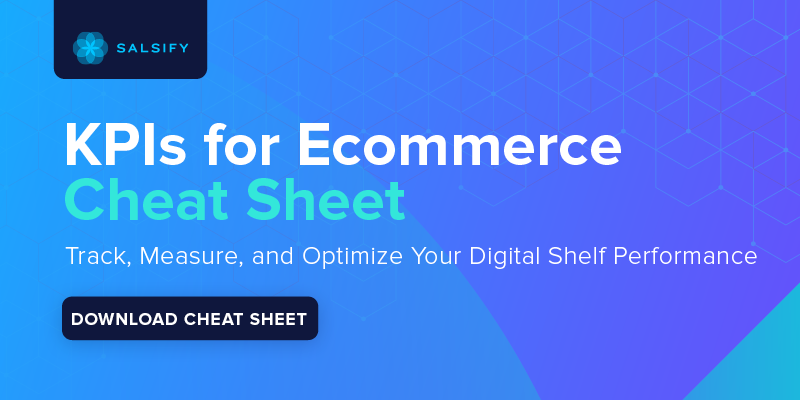

Essential Ecommerce KPIs for the Digital Shelf
Download our cheat sheet to get a quick list of everything you need to track, measure, and optimize your business goals.
DOWNLOAD CHEAT SHEETPIM
Manage all product content in one central system of record.
Syndication
Easily syndicate product content to every consumer touch point.
Enhanced Content
Enrich product pages with below-the-fold content and rich media.
Intelligence Suite
Bring AI-powered capabilities directly into your Salsify workflows.
Grocery Accelerator
Leverage the first-ever category-wide PXM accelerator in the grocery industry.
GDSN Data Pool
Synchronize standard supply chain, marketing, and ecommerce attributes globally.
Digital Shelf Analytics
Continuously optimize your organization’s product content syndication.
Catalog Sites
Share secure, on-brand, and always up-to-date digital product catalogs.
Automation and AI
Automate business processes and enhance Salsify workflows with AI.
PXM Platform, Integrations, and APIs
Integrate the PXM platform with the rest of your enterprise systems architecture.
Supplier Onboarding
Accelerate supplier onboarding while ensuring your schema requirements are met.
Product Listing
Sell products faster with Product Listing.
Content Enrichment
Increase online conversions with Content Enrichment.
Automation
Save time and increase operational efficiency with retail automation.
SXM Platform, Integrations, and APIs
Integrate the SXM platform with the rest of your enterprise systems architecture.
Syndication Network
Automate how you exchange product content data to the digital shelf.
Enhanced Content Network
Turn product pages into product experiences with Enhanced Content.
Commerce Platform Integrations
Create winning product experiences everywhere shoppers are, including on owned sites.
GDSN Data Pool
Synchronize standard supply chain, marketing, and ecommerce attributes globally.
Open Catalog
Connect to the digital shelf faster with an open, standardized, and free product catalog.
Resources
Resource Library
Explore our ecommerce resources to get everything you need to win on the digital shelf.
Blog
Read our blog to get actionable insights for navigating changing markets and industry demands.
Webinars
Watch our on-demand ecommerce webinars to gain expert advice and tips from our community of industry leaders.
Customer Blog
Gain the latest tips, industry trends, and actionable ecommerce insights.
Knowledge Base
Investigate our knowledge base to build your Salsify skills and understanding.
API
Examine our comprehensive API and webhook guides to start working with Salsify quickly.

Download the report to get expert insights, consumer research, and top industry trends.

Consumers are no longer craving the same old, same old from the food and beverage industry.
In a Deloitte study of more than 17,000 consumers across 15 European countries, 64% of respondents said that over the past year “they have become more interested in learning more about the influence of food on their health.”
Meanwhile, in the U.S., Food Business News notes that the Food and Drug Administration (FDA) is looking to expand food traceability requirements to provide more context for consumers when they make purchasing decisions.
For food and beverage companies, this shift makes it clear that a new approach is necessary for product detail pages (PDPs) and on-site keywords.
But what does this mean in practice? What are consumers searching for, and how can businesses effectively implement new terms to capture customer interest?
As New Food Magazine reports, health-conscious consumers have shifting priorities when it comes to their food and beverage preferences.
A few examples of popular ecommerce search queries include:
In-store customers are also becoming more health-focused. Research from SymphonyAI found that health-conscious consumers now represent between 25 and 30% of all grocery store shoppers in the U.S. and Europe.
Regardless of how customers purchase products — online or in person — they care about transparency. According to data from The Food Industry Association (FMI), 81% percent of shoppers say that transparency is important or extremely important to them.
In the context of food and beverage purchasing, transparency means providing a full list of ingredients along with any relevant certifications (such as USDA-certified organic) and complete nutritional information.
Metrics such as the healthy eating index (HEI) are bolstering the shift to a healthier food and beverage outlook as well.
First developed in 1995, the HEI uses a scale of 0 to 100 to assess how well foods align with recommendations in the Dietary Guidelines for Americans. As noted by the USDA Food and Nutrition Service, the higher the HEI number, the better.
Currently, the average HEI score for Americans is 58 out of 100, meaning there’s room for improvement as consumers look for healthier alternatives. By ensuring that food and beverages align with this index, companies can increase their chances of capturing health-conscious buyers.
So what are consumers looking for when they conduct food and beverage searches online?
In-store, consumers can examine labels in person or ask for help finding preferred products. However, the massive variety of online sellers means that customers generally start their search more broadly and then refine it as they come closer to what they’re looking for.
In other words, if brands and retailers can put the right keywords in the right place at the right time, they can capture top-of-funnel customers and get them heading in the right direction.
Consider recent Google Trends data. While keywords such as “ingredients” and “organic” saw sustained interest over the past two years — outpacing related terms such as “sustainable” — keywords like “natural” have consistently outperformed all three.
The more personally relevant and well-designed your PDPs, the better your chances of making a sale.
In the U.S., 70% of consumers say they’re more likely to buy if there are personally relevant images, videos, text, and reviews on a product page, while 50% of French consumers and 48% of those in Germany say the same, according to Salsify’s “Consumer Research 2022” report.
For food and beverage companies, this means there’s an urgency to create PDPs that speak to health-conscious consumer preferences — without making it seem like you’re simply keyword-stuffing or capitalizing on new trends.
By assessing customer behaviors and trends — such as the preference for complete and detailed nutrition information — companies can create product pages that include relevant keywords such as “natural” and “organic” to capture customer attention.
Then, you can build out pages that dive deeply into what ingredients these products contain, where they were manufactured, and how they stack up against metrics such as the HEI.
It's also critical to create cross-platform and asset connections that help drive consumers to your product pages. This means both accelerating the pace of content creation and pushing this content to multiple platforms including social media sites, industry publications, and company websites to help customers find exactly what they’re looking for.
Customer preferences are changing. To drive sales, brands and retailers must understand current market trends, prioritize popular keywords, and create content that delivers value to health-conscious consumers.

Download our cheat sheet to get a quick list of everything you need to track, measure, and optimize your business goals.
DOWNLOAD CHEAT SHEETDoug Bonderud (he/him) is an award-winning writer with expertise in ecommerce, customer experience, and the human condition. His ability to create readable, relatable articles is second to none.
Standing out on the digital shelf starts with access to the latest industry content. Subscribe to Below the Fold, our monthly content newsletter, and join other commerce leaders.